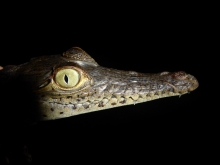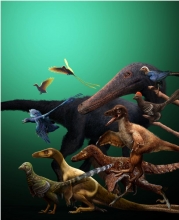Predators at the top of a marine food chain 130 million years ago ruled with more power than any modern species, McGill research into a marine ecosystem from the Cretaceous period revealed.

Microraptor was an opportunistic predator, feeding on fish, birds, lizards – and now small mammals. The discovery of a rare fossil reveals the creature was a generalist carnivore in the ancient ecosystem of dinosaurs.

A team of international researchers from Canada, Colombia, and Germany has discovered a new marine reptile. The specimen, a stunningly preserved metre-long skull, is one of the last surviving ichthyosaurs – ancient animals that look eerily like living swordfish.

Crocodiles are resilient animals from a lineage that has survived for over 200 million years. Skilled swimmers, crocodiles can travel long distances and live in freshwater or marine environments. But they can’t roam far on land. American crocodiles (Crocodylus acutus) are found in the Caribbean and Pacific coasts of the Neotropics but they arrived in the Pacific before Panama existed, according to researchers from McGill University.

Despite having bat-like wings, two small dinosaurs, Yi and Ambopteryx, struggled to fly, only managing to glide clumsily between the trees where they lived, according to a new study led by an international team of researchers, including McGill University Professor Hans Larsson. Unable to compete with other tree-dwelling dinosaurs and early birds, they went extinct after just a few million years.
Biologists now have a better idea of the origin of birds and the evolution of flight, two iconic events in the history of life on earth, thanks to work by a group of international scientists including a McGill professor. In updating the evolutionary tree, the team’s findings show some dinosaurs could fly before they evolved into birds, and many others were experimenting with powered flight.

The Hauffiopteryx altera, a new species of Ichthyosaur discovered by a McGill student Dirley Cortés, a PhD candidate in paleontology with Dr. Hans Larsson, Director of the Redpath Museum, has been described iPalaeontologia Electronica, 23(2):a30.
DOI: https://doi.org/10.26879/937 here.

New research using the most comprehensive study of feathered dinosaurs and early birds has revised the evolutionary relationships of dinosaurs at the origin of birds.

Hauffiopteryx altera (Latin for different from) has been identified as a new species of Ichthyosaurs by researchers from McGill University and the State Museum of Natural History Stuttgart in Germany.
Ichthyosaurs (‘fish lizards’), a group of tuna-shaped reptiles that inhabited Earth’s seas during the Mesozoic Era, were discovered by scientists in the early 19th century. Similar to the modern-day dolphin, ichthyosaurs underwent profound adaptions to aquatic environments including limbs transformed into flippers, a dorsal fin, and a tail fin.
Tyrannosaurus rex, one of the most feared predators in the Age of Dinosaurs, may have been built for endurance, not speed. A paper published Wednesday takes recent research on how mammals move and applies it to dinosaurs. Its conclusions support theories that the massive meat-eaters hunted in packs and opens a window into the ecology of the ancient forests they roamed. “We’re trying to figure out how much energy is going into and flowing through paleo ecosystems,” said Hans Larsson of Montreal’s McGill University, one of the paper’s co-authors.

While smaller dinosaurs needed speed, huge predators like T. rex were optimized for energy-efficient walking, according to a study published in PLOS ONE.

A fossilised insect wing discovered in an abandoned mine in Labrador has led palaeontologists from McGill University and the University of Gdańsk to identify a new hairy cicada species that lived around 100 million years ago.
Maculaferrum blaisi, described in a study published in Acta Palaeontologica Polonica, is the first hemipteran insect (true bug) to be discovered at the Redmond Formation, a fossil site from the Cretaceous period near Schefferville, Labrador.
New research spearheaded by scientists at McGill University reports that exposing chicken embryos, a model of higher vertebrate development, to leachate from crumb rubber used for example in artificial turf infill allowed to assess the toxicity of environmental pollutants contained in such material.

New research from a collaboration between Argentinian and University of Alberta and McGill University palaeontologists adds a new piece to the puzzle of snake evolution.
The researchers examined a strikingly well-preserved fossil of the rear-limbed snake Najash rionegrina, found in Argentina. The study shows that nearly 100 million years ago, these legged snakes still had a cheekbone—also known as a jugal bone—that has all but disappeared in their modern descendants.

